
How do the Japanese put in their two cents? ringi!
Articles, Japanese business, Japanese business keywordsInterestingly, on several occasions I have had Japanese participants in my cross-cultural seminars tell me that they were not familiar with the word ringi or the characters for them. Although the ringi is viewed as a quintessential aspect of Japanese decision-making processes, it seems that different terms are used to describe it in different companies. In some firms, it’s called an “A3”, after the name of the size of paper that it is often written on. In other firms, it may be called an RFA, meaning “request for approval.”
Yet, no matter what it’s called, in many Japanese organizations a ringi is a crucial component of decision-making. It’s the mechanism by which Japan’s famed consensus-based decisions are carried out. A ringi contains the case for a certain decision, laid out in a clear format, with all the data that needs to be considered attached to it. This document is then circulated to all the people who need to sign off on the decision. Each of them affixes their hanko (personal seal) to the document in order to show their approval. In a typical Japanese company, at any given time there are likely a number of ringi making their way through the company, collecting hanko.
The ringi system is well-suited to Japanese culture, because each person takes their time to carefully consider the issue, rather than being asked to make a snap decision in a meeting situation. Also, use of a ringi makes possible the avoidance of conflict, as there is no open debate involved. If someone does not agree with a ringi, they may simply put it in their desk drawer and never take it out again (this is in a sense the equivalent of a pocket veto in the U.S. lawmaking system — when the President fails to sign a bill within the 10 days allowed by the Constitution during the time when Congress is in adjournment, the bill is considered to have been vetoed.) In some cases, people who feel compelled to stamp a ringi even though they are not in agreement will register their displeasure through the symbolic gesture of stamping their hanko upside down. Either of these is a far cry from having to say in front of other people in a meeting “I disagree!”
In a system in which ringi are used, the role of originator of the ringi is an important one. The person who writes the ringi is the person who frames the question, and who gathers all the data to support the decision. Their selection of what information to include and what not to include is crucial, and the preparation of a solid ringi is an art in itself. In particular, in organizations that use the A3 format of a ringi, learning how to write a good A3 is something that all new employees are trained to do. It’s not easy, because all the relevant information needs to be compressed into a single (albeit rather large) page.
The originator of the ringi shepherds it through the system using nemawashi, a consensus-building technique. In the nemawashi processs, he or she will attempt to have a one-on-one conversation with all key people who need to sign off on the ringi, in order to attempt to convince them of the proposal’s merits. This will often take place even before the ringi is prepared, as a way to discover and head off objections at an early stage.
Related articles
The different meanings of psychological safety in Japan, Europe and North America
The concept of “psychological safety” in the workplace started in the United States in the 1960s and
Too early for cherry blossoms!
Japan’s cherry blossom season is peaking at the earliest time since records began over 1,200 y
Japanese Communicative Ambiguity: “When does Yes mean Yes?”
When Yes means Yes, No or Maybe. I am often asked by Americans and other Westerners working in Japan





